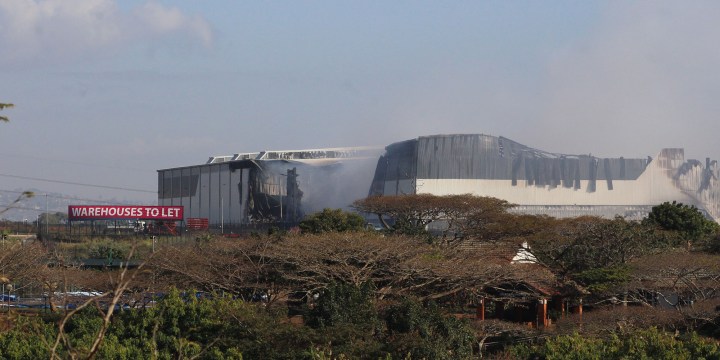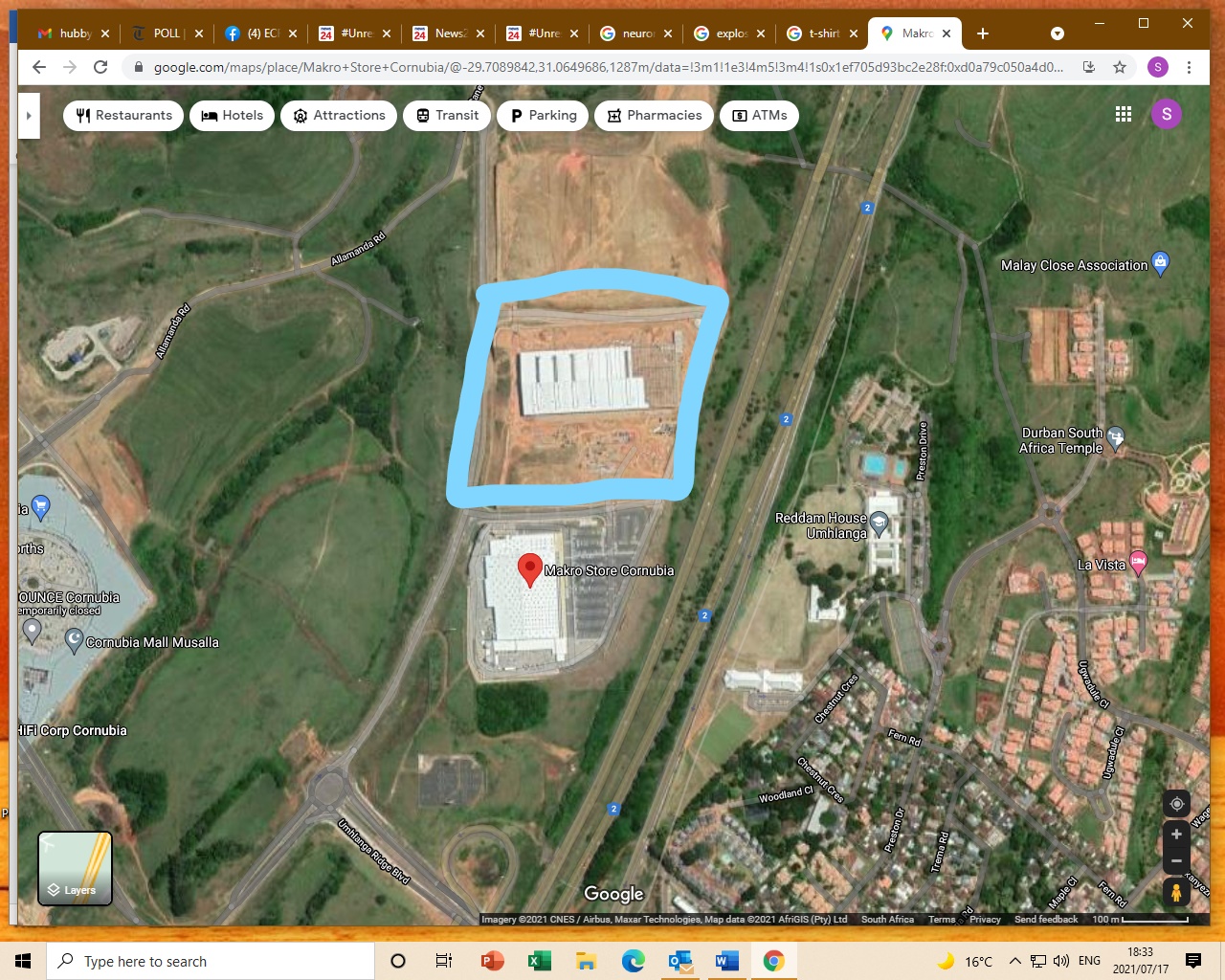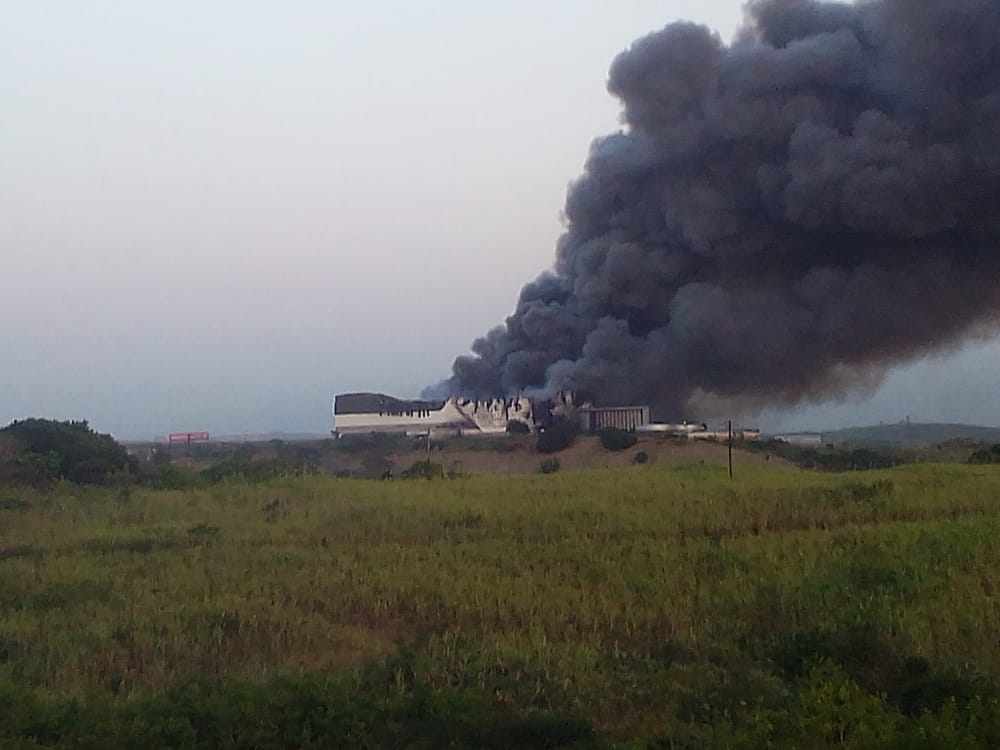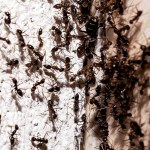OUR BURNING PLANET
Unanswered questions after arson attack at Durban pesticide warehouse and toxic air cloud

Swimming was finally banned on beaches north of Durban and residents warned to stay indoors at the weekend to avoid breathing noxious chemical fumes after the massive fire at a Durban pesticide warehouse – but seven days after the arson attack, questions remain unanswered about the human health risks, ecological impacts and poor communication to affected communities.
Thousands of Durban residents woke to the overpowering stench of burning chemicals almost a week ago, when arsonists and looters set fire to a massive warehouse containing toxic pesticides and chemical products owned by the Mumbai-based chemicals giant UPL.
The Indian multinational group was set up in 1969 as United Phosphorus Limited by chemist Rajju Shroff and now boasts that it is the fifth biggest agrochemical company in the world (after Bayer, Dupont, Syngenta and BASF) with annual revenue of $5.04-billion
In a press statement released almost five days after the fire began, the company confirmed that the attack led to “a large plume of smoke being released into the atmosphere as well as causing water to overrun catchment devices” from its new Cornubia warehouse.
Hedging its bets over whether it was solely or partly responsible for the toxic air cloud or the water-borne effluents that wiped out fish life in the Umhlanga Lagoon and also killed marine life near beaches north of Durban, the company said: “While the number of fires in the vicinity makes it difficult to accurately assess the nature of possible air pollution, experts have advised that, as a precautionary measure, people should remain inside if they’re in the area of a smoke cloud. People are also advised to cover their eyes and nose by wearing an ordinary mask and glasses over their eyes.”
Euphemistically describing the warehouse contents as “plant protection products”, UPL media spokesperson Craig Dodds has not responded to requests from Daily Maverick for a detailed list of the specific types and volumes of toxic compounds stored at the facility – nor fully explained how the “state-of-the-art safety features” were apparently overwhelmed to allow the complete collapse of the building and for polluted effluents to run directly into a stream which leads into Umhlanga Lagoon and the Indian Ocean. (See full UPL responses to questions below.)
However, an inspection of the products marketed on UPL’s South African division website reveals a long list of hundreds of insecticides, pesticides, fungicides, herbicides, rodenticides, surfactants and fumigants – including several compounds that have been linked to death, cancer and birth defects in humans or animals.
Some of the chemicals include 2,4-D, glyphosate, paraquat, chlorophenoxy, triclopyr butoxy ethyl esters, atrazine, carbofuran, cyanamide and chlorpyrifos (For a full list of hazardous data sheets of the products marketed by UPL South Africa see here)

Though it remains unclear what exactly was in the warehouse at the time of the fire, the Indian agrochemicals chemicals giant UPL markets a wide range of highly toxic formulations on its South African website.(Images: UPL website products list)
Residents of neighbouring suburbs including Umhlanga, La Lucia, Cornubia, Durban North, Prestondale and Glen Anil also raised concern that the company and city authorities failed to issue any health warnings until at least five days after the fire began. Even then, the precise nature of the pollution had not been disclosed.
Further concerns have also been raised about why a major storage facility housing hazardous and toxic chemicals did not have bunding to contain the deadly overflow into the environment. Bunds are similar to large concrete moats that are designed to capture and contain effluent overflow and pollution – even in the event of heavy rainfall and the large volumes of water often used to fight fires.
Rory Macpherson, councillor for Mount Edgecombe/Umhlanga seemed exasperated by the difficulty he experienced in sourcing credible information about the health risks of breathing toxic fumes and suggested that had it not been for information supplied by concerned activists, liquid effluent from the site might still be flowing on to some of the city’s most popular beaches.
“My assessment has been that the responses and communication from the authorities has been awful. We deserve such information and it should not be left to people like me to try and find out what’s going on.”
“This also raises questions about whether we are properly prepared to react swiftly during future catastrophes – even if it means getting armed forces to guard the lives of firemen and emergency personnel.
“The smell is still overwhelming six days later and we can’t get information on the potential harm. We still have no independent scientific lab reports on what was released. If it’s all good, tell us. If it’s half good and half bad tell us. If it’s very bad, tell us – then we can evacuate. I feel we have been let down by the authorities… and perhaps even the owners. They should be putting out regular statements. This was a Presidential Catalytic Project. Where were the defences for this investment?”
Local environmental consultant Nancy Oosthuizen was also concerned about the potential health risks for nearby residents exposed to chemical fumes.
“They should have notified us,” she said, noting that her daughter in Sunningdale had been forced to close her windows to keep the smell out at times, while residents in Prestondale were even more worried due to their close proximity to the site.
Environmental attorney Melissa Strydom has requested detailed information on the toxicity risks and noted that the company is obliged under the National Environmental Management Act to make such information available.
“The situation seems dire, and I appreciate that your client and the authorities are attending to it,” she wrote in an email message to the company. “Still, the communications and mitigation measures (particularly being communicated to the surrounding communities) appear lacking.”
In its media statement, UPL suggested that “repeated attacks, as well as the unrest” had prevented a more rapid response.
But other sources have painted a somewhat different picture.
eThekwini Fire Department Divisional Commander Bruce de Gier noted that the warehouse caved in and collapsed within the space of about an hour after a massive fireball explosion tore through the roof of the warehouse, ripping the overhead sprinkler systems and water pipes out of the walls and roof.
The remains of smouldering chemical drums and canisters were now covered by tons of metal sheeting, steel beams, brick and concrete debris, making it impossible to douse the fire completely.

Hazardous waste workers try to plug the flow of poisonous effluents about 500m from the perimeter of the UPL warehouse. (Photo: Tony Carnie)
“The fireball went through the roof in front of our eyes. The building was completely destroyed. It looks like Hiroshima inside there now.”
As a safety precaution to protect personnel from chemical exposure, he said, firefighters had remained upwind of the burning warehouse as they tried to hose down the flames.
De Gier emphatically denied anecdotal reports from Macpherson and another source that fire hydrants around the warehouse may have been sabotaged by arsonists or looters.
He confirmed that perimeter gates and doors to the factory had been ripped down and that five trucks next to the warehouse had also been set on fire, but his firefighters had been able to pump water from hydrants for at least five hours, before pressure problems developed and had to be repaired by municipal water staff.
De Gier said the remaining chemical products were expected to keep burning for at least “a couple of days” because firefighters were unable to douse the smouldering chemical residue until the debris was removed. The faster the debris could be physically removed by a demolition company, the faster the embers could be extinguished.
He suggested that roughly 90% of the chemicals had been destroyed or melted by the initial fireball with liquid residue leaking down a driveway off the site into stormwater drains. Many of the chemicals appeared to have been stored in 200-litre drums or 25-litre plastic containers, which melted from the heat.
When Daily Maverick visited the site on Sunday, hazardous chemical response company Spilltech was cordoning off a stormwater drain about 500m away from the perimeter of the warehouse.
From an ecological perspective, the toxic pollution that has also leaked into the Umhlanga estuary appears to have wiped out fish and multiple estuarine organisms, while crayfish and other marine life have also been washing up as far north at Umdloti.
In a media statement on Saturday, the eThekwini Municipality said: “As a precautionary measure, residents are advised to continue to close windows and doors and to put wet cloths over vents until smoke clears.
“Authorities are urging the public to refrain from picking up and collecting dead marine life off the Umdloti and Umhlanga coastline as they have been contaminated with toxic chemicals and could be harmful to humans.
“The public is also reminded that the beaches north of the Umgeni River are closed as a precautionary measure. The public is advised to refrain from all recreational activities, including fishing or surfing, bait collection and picking up of dead species. Collecting or harvesting of any marine living resource in the area is temporarily prohibited until the cause is determined and the threat has abated.” DM/OBP
UPL RESPONDS TO QUESTIONS
- On what date did the UPL Cornubia warehouse become operational?
It’s been operational since 1 April 2021, when UPL’s lease commenced.
- Why has it taken UPL so long to issue a human health warning and precautionary advice to neighbouring communities about the air inhalation risks of burning pesticides and other toxic chemical substances from the UPL fire?
It’s not accurate to say that UPL has taken a long time to issue warnings. The looting and arson event that resulted in the fire took place throughout the evening of the 12th July and the early hours of the 13th July 2021. Before this, UPL had notified the fire department and a spill response company to be on standby in the event of an attack on the site. However, with the violence which continued through 13th of July and ongoing instability even after this, the fire department was unable to respond immediately.
UPL appointed an environmental consultancy agency at 9.45am on the 13th July and official notice was given to the Director-General of Environmental Affairs, the provincial head, the municipality/City Health by midday. UPL were advised that it was these authorities’ prerogative to put out notices to the general public, and was given the assurance this was being done. UPL was in constant contact with the authorities, checking and following up to ensure the notices went out.
Notwithstanding the official communication by the competent authorities, UPL advised the property manager, Excellerate JHI, to advise the local community of the situation, which they did. UPL also advised the largest residential estate in the area and sent them details of precautionary measures. In addition, UPL appointed a security company to distribute flyers in the nearby informal settlement. Testing of samples to establish the nature of substances released into the environment was also delayed because of difficulty gaining access to the site and transporting samples to Johannesburg for testing, given that local laboratories have been closed until now.
- UPL’s website lists over 200 herbicides, pesticides, fungicides etc marketed by the company’s South African operation – several of which are extremely toxic, hazardous or carcinogenic. Can UPL confirm which of these formulations were stored at the Cornubia warehouse when the fire broke out – and the quantities thereof?
This information has been shared with the relevant authorities to inform their communication to the public. It is not possible, however, to provide a definitive list of what has actually been released into the environment as it’s not clear at this stage what the burning of those products, as well as packaging, may have produced. Note these products are not generally ever burnt.
Releasing the full list of products stored at the warehouse will not make it any clearer to the public what has a: actually been released into the environment; b: what they may have actually inhaled, given numerous other fires in the area or c; the levels of exposure or risks. It may instead create unnecessary anxiety. Test results will be made known as soon as possible to give accurate information.
- What advice/measures is UPL offering to residents of surrounding residential areas to protect their health?
While the number of fires in the vicinity makes it difficult to accurately assess the nature of possible air pollution, experts have advised that, as a precautionary measure, people should remain inside if they’re in the area of a smoke cloud. People are also advised to cover their eyes and nose by wearing an ordinary mask and glasses over their eyes. The eThekwini Municipality has also closed all Durban North beaches as a precaution. In addition to these warnings, the flyer distributed to the informal settlement near the stream/river advised them not to use the water.
- Leaving aside the fact that this appears to have been an arson attack, what standard emergency containment measures were put in place during the design of the facility to ensure that no toxic or hazardous substances left the site to pollute rivers and the surrounding environment via heavy rain or firefighting activity in the event of a disaster?
It was a brand-new state of the art facility; however, this question is best addressed to the landlord.
- Please describe the exact nature of these emergency containment water overflow at Cornubia ? Is there any bunding or onsite water retention/overflow dams on the site? If not, why not?
(Question not responded to.)
- If the warehouse has underground sumps to collect water/chemical waste, can UPL explain why there evidently appears to have been insufficient design capacity in the sump system to contain/avoid polluted water overflows into the environment.? (It is also noted that no rain has fallen in Durban for the past two weeks at least.)
The problem was the delayed access to the site due to the security situation. The sumps overflowed because they couldn’t be emptied as they would have been under normal circumstances.
- Can UPL provide a summary copy of its approved Environmental Management Plan?
The plan will be submitted as part of UPL’s compliance to the National Environmental Management Act (Act 107 of 1998). However, it’s worth noting that the plan became somewhat academic due to the extraordinary circumstances which could not have been foreseen, notably the civil unrest which resulted in the looting and arson and barricading of access routes which resulted in the long delay in the fire department and other response services being able to access the site. In addition, due to the civil unrest all of the support services were understaffed and stretched to capacity in having to attend to multiple sites. DM/OBP






















 Become an Insider
Become an Insider
As a landlord I steer clear of anything dangerous (we are on a river and we have a mix of tenants including food factories)
High hazard facilities like this don’t belong in normal places. There are many queries or old land fill sites that are by nature containment sites.
btw has anybody figured out why this place was targeted? Hardly as if looters want these chemicals… Hopefully leaders and motive are investigated for terrorism charges.
KEY QUESTION: Was the facility a Major Hazardous Installation (MHI)? Section 43 of the Occupational Health and Safety Act, 1993 (Act No. 85 of 1993)
In all probability by law it should have been. And thus the local government should also be complying with Section 9 (1, 2 & 3) of the referenced document.
9. (1 ) Without derogating fiom the provisions of the National Building Regulations and
Building Standards Act, 1977 (Act No. 103 of 1977), no local government shall
permit the erection of a new major hazard installation at a separation distance less
than that which poses a risk to –
(a) airports;
(b) neighbouring independent major hazard installations;
(c) housing and other centres of population; or
( d ) any other similar facility:
Provided that the local government shall permit new property development only
where there is a separation distance which will not pose a risk in terms of the risk
assessment: Provided further that the local government shall prevent any
development adjacent to an installation that will result in that installation being
declared a major hazard installation.
There is residential and the Reddam School at a distance of about 600 m from this facility – reference Google Earth.
Just unbelievable. I guess this paves the way for the karpowerships since there will be no environment left to pollute